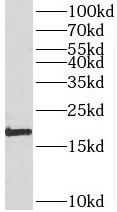Products
SNX3 antibody
| Size | Price |
|---|---|
| 100µg | Inquiry |
- SPECIFICATIONS
- FIGURES
- CONDITIONS
- FAQS
- Product Name
- SNX3 antibody
- Catalogue No.
- FNab08091
- Size
- 100μg
- Form
- liquid
- Purification
- Immunogen affinity purified
- Purity
- ≥95% as determined by SDS-PAGE
- Clonality
- polyclonal
- Isotype
- IgG
- Storage
- PBS with 0.02% sodium azide and 50% glycerol pH 7.3, -20℃ for 12 months(Avoid repeated freeze / thaw cycles.)
- Immunogen
- sorting nexin 3
- Alternative Names
- Sorting nexin-3|Protein SDP3|SNX3 antibody
- UniProt ID
- O60493
- Observed MW
- 16-20 kDa
- Tested Applications
- ELISA, WB, IF
- Recommended dilution
- WB: 1:500-1:2000; IF: 1:20-1:200
 COLO 320 cells were subjected to SDS PAGE followed by western blot with FNab08091(SNX3 antibody) at dilution of 1:500
COLO 320 cells were subjected to SDS PAGE followed by western blot with FNab08091(SNX3 antibody) at dilution of 1:500
- Background
- Phosphoinositide-binding protein required for multivesicular body formation. Specifically binds phosphatidylinositol 3-phosphate(PtdIns(P3)). Also can bind phosphatidylinositol 4-phosphate(PtdIns(P4)), phosphatidylinositol 5-phosphate(PtdIns(P5)) and phosphatidylinositol 3,5-biphosphate(PtdIns(3,5)P2)(By similarity). Plays a role in protein transport between cellular compartments. Together with RAB7A facilitates endosome membrane association of the retromer cargo-selective subcomplex(CSC/VPS). May in part act as component of the SNX3-retromer complex which mediates the retrograde endosome-to-TGN transport of WLS distinct from the SNX-BAR retromer pathway(PubMed:21725319, PubMed:24344282). Promotes stability and cell surface expression of epithelial sodium channel(ENAC) subunits SCNN1A and SCNN1G(By similarity). Not involved in EGFR degradation. Involved in the regulation of phagocytosis in dendritic cells possibly by regulating EEA1 recruitment to the nascent phagosomes(PubMed:23237080). Involved in iron homeostasis through regulation of endocytic recycling of the transferrin receptor TFRC presumably by delivering the tranferrin:transferrin receptor complex to recycling endosomes; the function may involve the CSC retromer subcomplex(By similarity). In the case of Salmonella enterica infection plays arole in maturation of the Salmonella-containing vacuole(SCV) and promotes recruitment of LAMP1 to SCVs(PubMed:20482551).
How many times can antibodies be recycled?
First, usually it's not suggested to recycle antibodies. After use, buffer system of antibodies has changed. The storage condition of recycled antibodies for different customers also varies. Thus, the performance efficiency of recycled antibodies can’t be guaranteed. Besides, FineTest ever conducted the antibody recycling assay. Assay results show recycling times of different antibodies also varies. Usually, higher antibody titer allows more repeated use. Customers can determine based on experimental requirements.
Notes: After incubation, we recycle rest antibodies to centrifuge tube and store at 4℃. High titer antibodies can be stored for a minimum of one week. Reuse about three times.
What are components of FineTest antibody buffer?
Components of FineTest antibody buffer are usually PBS with proclin300 or sodium azide, BSA, 50% glycerol. Common preservative is proclin300 or sodium azide, which is widely applied in the lab and industry.
How about the storage temperature and duration of FineTest antibodies?
Most antibodies are stored at -20℃. Directly-labeled flow cytometry antibodies should be stored at 2 - 8℃. The shelf life is one year. If after sales issues for purchased antibodies appear, return or replacement is available. Usually, antibodies can be still used after the one-year warranty. We can offer technical support services.
Is dilution required for FineTest antibodies? What’s the dilute solution?
Directly-labeled flow cytometry antibodies are ready-to-use without dilution. Other antibodies are usually concentrated. Follow the dilution ratio suggested in the manual. Dilute solution for different experiments also varies. Common antibody dilution buffers are acceptable(e.g. PBST, TBST, antibody blocking buffer).
How to retrieve antibodies for immunohistochemistry?
Common retrieval buffers: Tris-EDTA Buffer(pH 9.0); Citrate Buffer(pH 6.0)
Heat induced antibody retrieval:
Method 1: Water-bath heating: Put the beaker with retrieval buffer and slide in the boiling water bath. Keep the boiling state for 15min. Naturally cool to room temperature;
Method 2: Microwave retrieval: Put the beaker with retrieval buffer and slide in the microwave oven. Heat at high power for 5min, Switch OFF for 3min, Heat at medium power for 5min. Naturally cool to room temperature.
How to choose secondary antibodies?
(1) Secondary antibodies react with primary antibodies. Thus, secondary antibodies should be against host species of primary antibodies. E.g. If the primary antibody is derived from rabbit, the relevant secondary antibody should be against rabbit. E.g. goat anti rabbit or donkey anti rabbit.
(2) Choose secondary antibody conjugates according to the experimental type, e.g. ELISA, WB, IHC etc. Common enzyme conjugated secondary antibodies are labelled by HRP, AP etc. Fluorescin or dye labelled secondary antibodies are applied in immunofluorescence and flow cytometry(e.g. FITC, Cy3).
